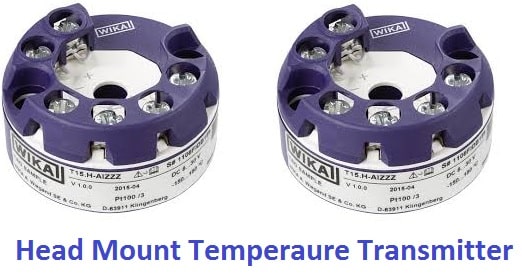Head mount transmitter converts the temperature signal into a 2 wire loop powered 4 to 20 mA signal. Head mount transmitter receives the temperature signal from resistance temperature detector(RTD), Thermocouple(TC), etc. It is mounted inside the connection head of the temperature sensor probe.
What is Head Mount Temperature Transmitter?

The conventional temperature transmitter receives the temperature signal from the sensor. The sensor is generally far away from the transmitter. It is because the conventional transmitter can not work at high temperatures. Therefore, we mount the conventional transmitter in an instrument room. The head mount transmitter can function reliably at a higher temperature. Therefore, the Head mount transmitter is housed in the connection head of the sensor. This leads to the compactness of the transmitter and it requires minimal wiring in the head section of the sensor.
If the distance between sensor and transmitter is more then we need to take additional precautions for mitigating the effect of lead wire resistance. In conventional transmitter lead wire, compensation is required for the minimization of measurement error. Also, the increased length of the cable incurs extra costs. With a thermocouple sensor, an additional thermocouple compensating cable is required for a conventional transmitter.
However, in the case of a head mount transmitter, the following are not required.
- lead wire compensation for RTD sensor
- Thermocouple compensation cable for thermocouple sensor
Because of the above features of the head mount transmitter, its measurement accuracy is very good.
The head mount transmitter is a universal transmitter and has a HART communication protocol. We can program it remotely for the parameters like- temperature range, and type of sensor. Also, calibration of the temperature transmitter is possible from the remote station.
The Salient features of the Head Mount Temperature Transmitter are as follows.
- It accepts all the temperature inputs from Pt-100 input and Types J/K/T/E/R/S/B/N Thermocouples.
- We can configure the transmitter with PC software remotely.
- Universal setting with HART protocol for various input signals pt-100, TC, etc.
- The transmitter has two types of isolation – galvanic and optical isolation. As a result, the signal-to-noise ratio is more. It does not affect noise signals. And, the loop grounding problem is not there because of isolation.
- It has non-volatile memory which can store the data permanently. Thus data logging is one of the best features of the head mount transmitter.
- In case of an increase in temperature the transmitter measurement error increase. To mitigate it, the transmitter has an internal temperature sensor for active temperature compensation
Advantages of Head Mount Temperature Transmitter
- Higher measurement accuracy
- No compensating cable with the use of thermocouples
- No Lead Wire Compensation with use of RTD
- Unaffected with electrical noise
- Low Signal to Noise ( S/N) Ratio
- Built-in temperature compensation
- Built-in cold junction compensation
- Easy replacement of the sensor and transmitter.
- Programming of various input signals from remote
- Remote Calibration of the transmitter
- Easy Troubleshooting
- Reduced cabling makes the circuit simple and reduces the cost
- Overall Low cost
Related Post